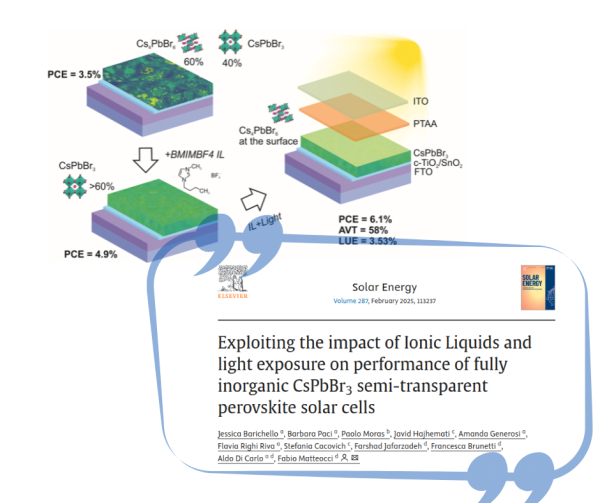Inorganic wide-bandgap CsPbBr3 perovskite is an interesting material to investigate for several opto-electronic devices such as solar cells, detectors, and light emitting diodes. Although the 2.3eV-bandgap limits the achievement of power conversion efficiencies (PCEs) larger than 10% in opaque perovskite solar cells (PSC), these materials are still interesting in several photovoltaic (PV) fields, such as Building Integrated PV and agri-PV, where the semi-transparency of the device stack can represent an additional value. However, the single-step solution processing is challenging due to the limited solubility of the precursors. Although sequential deposition of PbBr2 and CsBr could mitigate this issue, further concerns occurred on the achievement of pure α-phase CsPbBr3 thin film.
In this work, we developed a deposition process where the use of BMIM-BF4 ionic liquid in PbBr2 deposition helps the formation of CsPbBr3 with improved uniformity and reduced presence of competitive perovskite phases. Thanks to the ionic liquid addition, the PCE was drastically improved up to 6.33% on semi-transparent PSCs using sputtered Indium Tin Oxide as transparent top contact. The Average Visible Transmittance of the full device stack exceeded 58% with Light Utilization Efficiency greater than 3.67%. Finally, we investigated thank to photoemission spectroscopy and in-situ XRD analysis the impact of the light exposure in the bulk and/or at the surface of thin film.
Exploiting the impact of Ionic Liquids and light exposure on performance of fully inorganic CsPbBr3 semi-transparent perovskite solar cells - New article
In this article published in Solar Energy, the result of a collaboration between CNR-ISM, the University of Tor Vergata, and Institut Photovoltaïque d'Île-de-France, the focus is on CsPbBr3 perovskite, a promising material ideal for photovoltaic devices.
Its semi-transparency paves the way for various innovative applications, such as solar windows, agrivoltaic solutions, and indoor energy-harvesting devices. However, to compete effectively in the market, improving its efficiency is essential.
By employing an ionic liquid, the fabrication process has been optimized, leading to a significant increase in overall conversion efficiency. This advancement marks a crucial step forward in the development of more efficient and versatile photovoltaic technologies.
